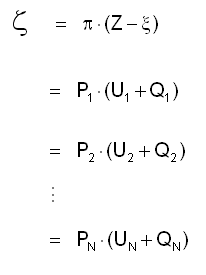The money price of money being known through its definition as exactly 1, we expect to find all sectors operating such that their marginal value for their economy’s currency will tend toward unity. P0K will be calculated so as to make unity the current consensus of money’s marginal values among all the sectors in an economy K.
As has so often been the case, calculations begin with an economic sector IK’s financial discriminant z $/year, i.e.: the central equality uniting the price, utility parameter, and physical flow associated with each axis of the utility function by which an economic sector is defined:
 Eqa. 2-3
Eqa. 2-3
A useful summa of a sector’s current state simply adds up all h=N+1 of the Equations 2-3:
This allows consolidation of the interaction between prices and utility parameters in a single parameter u:

and isolates a parameter -f to express a sector’s earnings (in the negative — profits are coming ‘back to us’ out of economic activity):

Parameters u and -f then summarize z as follows:

This development of z is derivative of the purely abstract notion of general optimality; and the u and f at which it arrives are both defined in terms of all the commodities’ current money prices. Conditioning this equation so that it might serve price computations will therefore require that its elements be stated in terms of a sector’s current physical and monetary states.
The financial discriminant z will of course be
replaced by the b developed for use in
computing marginal costs of production and
values of marginal product. Financial services f present no issue in this regard because, once again, current
dividends -eIK can be substituted. And the
interaction u of money prices
with utility parameters can be shown to bring P0K into the analysis by
introducing a value
equivalent ![]() for
u that is computed on
the basis of absolute commodity values YJ
for
u that is computed on
the basis of absolute commodity values YJ G/unit:

P0K, the money price of one unit of constant value, is to become the scalar
$/G by which money prices PJK $/unit are related to commodity
values YJ G/unit. It must
therefore relate u
to ![]() as follows:
as follows:

Substitutions of the above into our equation for the financial discriminant expresses a sector IK’s current state as ...

wherein P0K is the only unknown.
The an economy K's consensus P0K derives from adding all its current financial discriminants bIK and solving the sum for P0K ...

... where sector I=0 is understood to receive
negative sums on eIK and
![]() IK; and
IK; and

Finally, note that Model 0’s portrait of financial intermediation as transparent has e0K always equaling zero.
Determination of P0K completes Model 0’s cycle of computations: money prices PJK are now known; financial discriminants zIK follow, thereby originating demands QIJK. Demands are then translated into the asset replenishment rates RIJK that drive the physical adjustment process giving rise to the physical state by which Model 0 assesses commodities’ absolute values YJ. Money prices PJK also interact with asset replenishment rates RIJK to form the net cash flows -rIK that drive the financial adjustment processes giving rise to Model 0’s financial state [kIK,gIK] and the eIK’s by which an economy K’s currency is valued.
